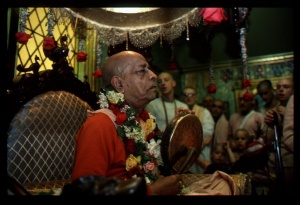CC Antya 18.97 (1975)

A.C. Bhaktivedanta Swami Prabhupada
Below is the 1996 edition text, ready to be substituted with the 1975 one using the compile form.
TEXT 97
- padmotpala—acetana, cakravāka—sacetana,
- cakravāke padma āsvādaya
- ihāṅ duṅhāra ulṭā sthiti, dharma haila viparīti,
- kṛṣṇera rājye aiche nyāya haya
SYNONYMS
padma-utpala—the blue and red lotus flowers; acetana—unconscious; cakravāka—the cakravāka birds; sa-cetana—conscious; cakravāke—the cakravāka birds; padma—the blue lotus flowers; āsvādaya—taste; ihāṅ—here; duṅhāra—of both of them; ulṭā sthiti—the reverse situation; dharma—characteristic nature; haila—became; viparīti—reversed; kṛṣṇera—of Lord Kṛṣṇa; rājye—in the kingdom; aiche—such; nyāya—principle; haya—there is.
TRANSLATION
“Blue and red lotus flowers are unconscious objects, whereas cakravākas are conscious and alive. Nevertheless, in ecstatic love, the blue lotuses began to taste the cakravākas. This is a reversal of their natural behavior, but in Lord Kṛṣṇa’s kingdom such reversals are a principle of His pastimes.
PURPORT
Generally the cakravāka bird tastes the lotus flower, but in Kṛṣṇa’s pastimes the lotus, which is usually lifeless, tastes the cakravāka bird.